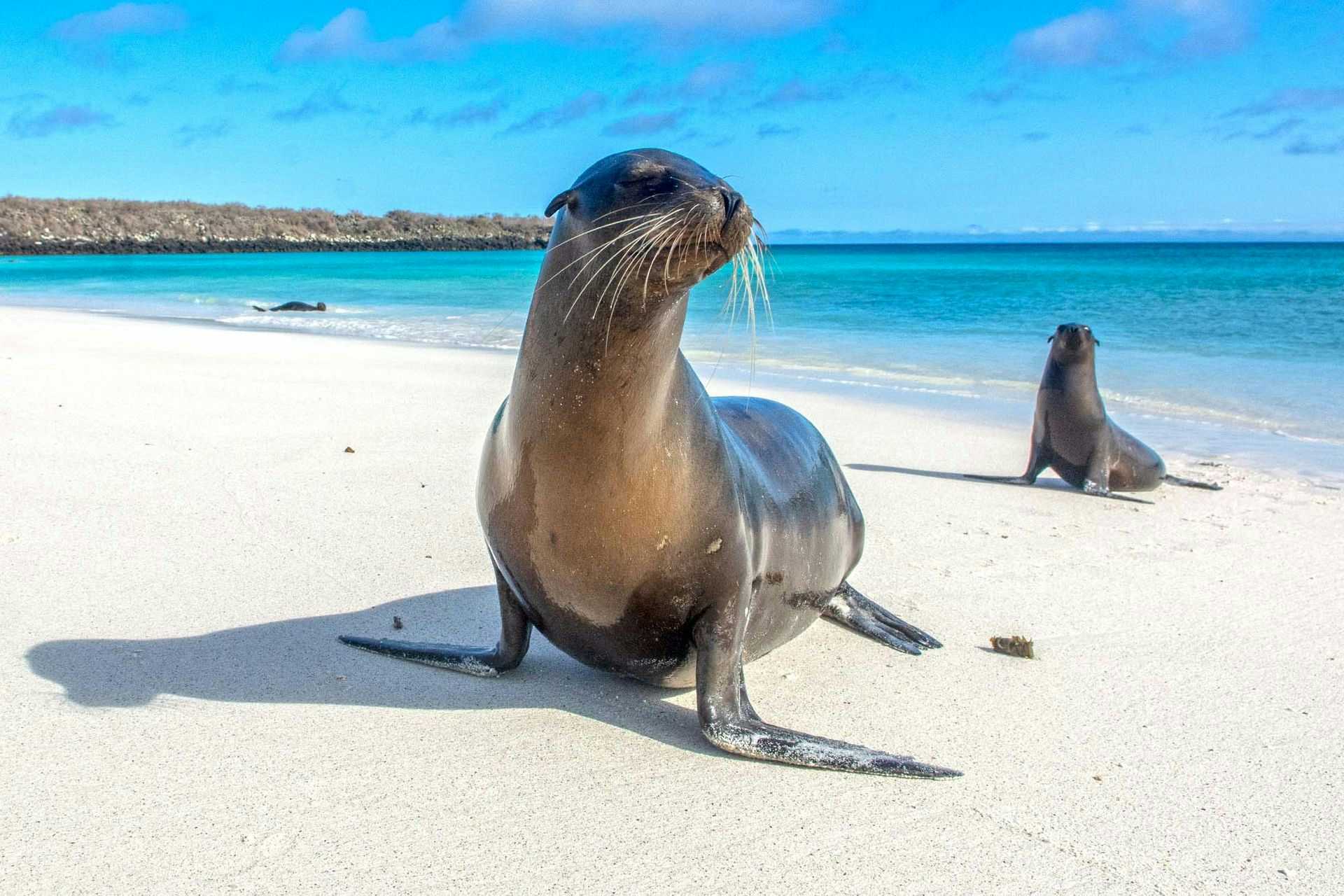Why Ecuador is so much more than just the Galapagos Islands
A Round Trip of the Andes, the Amazon and the Galapagos
Read more
About My Trip
Ecuador is one of the most diverse countries in the world. With rainforests, mountains, and a unique archipelago. I embarked on a 3-week journey visiting both well-known and lesser-known places. I really enjoyed meeting the different indigenous cultures of Ecuador.
Visiting Ecuador?
 I travelled with Rebecca Adventure Travel, a local tour operator headquartered in Quito. With expertise in Adventure Travel, our operations extend to a travel concept store in Zutphen, the Netherlands, providing in-person travel advice for journeys to Ecuador, Colombia, or Peru. She arranged a complete tour of Ecuador for me. Do you want to do this too? Then visit her website.
More information: Rebecca Adventure Travel
I travelled with Rebecca Adventure Travel, a local tour operator headquartered in Quito. With expertise in Adventure Travel, our operations extend to a travel concept store in Zutphen, the Netherlands, providing in-person travel advice for journeys to Ecuador, Colombia, or Peru. She arranged a complete tour of Ecuador for me. Do you want to do this too? Then visit her website.
More information: Rebecca Adventure TravelWhen you mention Ecuador, many nature lovers immediately think of the Galapagos Islands. It is where researcher Charles Darwin became convinced of his evolution theory.
Of course, a visit to the Galapagos Islands is worthwhile, but Ecuador has much more to offer. Hiking above 4,000 meters in the Andes Mountains is one of the highlights of my trip. After that, I dived into the steamy Amazon rainforest in search of indigenous cultures and wonderful wildlife. During this three-week tour, I visited the well-known highlights, but I have also intentionally picked some lesser-known places. The famous Yasuni National Park in the Amazon is on the itinerary, but when I heard about Cajas National Park high in the Andes, I wanted to go there as well.
Logically, the capital Quito, a UNESCO World Heritage site, is on my list. As well as the city of Cuenca, which is especially beloved by Ecuadorians. Additionally, I want to discover the famous market of Otavalo. And obviously, the Galapagos Islands, where I will cruise around the different islands. However, it would be more accurate to say that I am visiting the many fascinating animals that live there.
Diversity has become an important criterion in all my travels. I enjoy visiting cities and nature reserves during a trip, both well-known and lesser-known places. Either with a guide or just on my own. And I don't like to rush when I travel, I prefer to stay a bit longer so I can take my time. Which gives me more time to truly experience the places I visit. To get to know the people, taste the local food, take in the surroundings, and more. You can make your stay more intense and it gives you a more in-depth experience.
The Wonderful City of Quito
My starting point is Quito, like almost everyone as you most likely land in the capital. It is a colourful introduction to the South American lifestyle. Life takes place on the streets, with many small shops, old colonial buildings, lively music around you, and people chatting. It is a city of many churches and a cathedral, but also of delicious food.
I'm doing a tasting of various local fresh dishes with chef Juan Sebastían Pérez of the popular Quitu restaurant. He and his staff prepare four local dishes, which are served neatly at the bar with explanations. Including a ceviche of fresh fish, one of the most popular dishes in the country, a dish with lamb and lots of fresh vegetables. As I walk through the capital, I see cacao in various places. There are tastings too, with even 100% pure chocolate.
I enter the shop of Yumbos Chocolate, which is located opposite the famous San Francisco Church. "My job is to change people's taste. Everyone loves chocolate, but they don't know real chocolate," says the guide firmly as he lets me taste a piece. "Hold the 100 per cent cacao on the tip of your tongue and press it against your palate." With the various flavoured chocolates, you have to chew so that all the flavours come together. 80 per cent of all products go to Belgium and Switzerland, where chocolate is literally made from it.
I also go on various excursions outside of Quito. The city is surrounded by an immense green corridor, so I visit two unknown places. In the El Pahuma Orchid Reserve, I hike amidst orchids and waterfalls, accompanied by the loud chirping of birds. The inhabitants of the Yunguilla Cloud Forest are known for their Community-Based Tourism. You can see how the local population lives sustainably high up in the mountains. Additionally, you can help make fresh cheese and banana chips, for example. Or support them by buying some.
Read my article on Quito
The Otavalo Market
The market of Otavalo is famous. It is located about a two-hour drive from Quito. I will travel by bicycle, or rather by mountain bike. With a guide. I will follow the old railway track to Otavalo, passing through villages, fields, and farms.
I am greeted by dogs, pigs, and alpacas when I arrive at the starting point of my mountain bike trip. Before we go, we start with a local breakfast: Bizcocho (biscuits) with 'twisted' cheese and 'dulce de leche' (caramel spread). I am allowed to visit the kitchen and see for myself how the cookies are freshly made. The smell alone makes me hungry.
According to many, it is the most colourful market in South America. A large number of local women still wear traditional clothing. With a hat, black dress, white blouse, and matching blue overcoat. The hair is braided, and that has a meaning. A single braid indicates that she is single, a double braid means she is married. They walk to the market to sell their freshly grown vegetables and fruit.
You can also find a lot of ready-to-eat food there, as well as clothing, bags, and musical instruments. The well-known souvenirs for tourists are (fortunately) scarce. Although in reality, everything is a souvenir.
Read my article on Otavalo
The Mighty Yasuni National Park
The Amazon is both frightening and fascinating. It is the largest rainforest in the world, full of wildlife, but also dangerous if you get lost in it.
Ecuador has the immense Yasuni National Park with the famous Napo Wildlife Refuge. This ecolodge is located by a lake in the jungle. It doesn't get much better than this.
I am woken up early in the morning by loud howler monkeys. The male lives up to his name with great passion. Macaws and toucans fly by, while the lake is filled with caimans. I take a closer look, some of them are four meters long. The jungle around me is awakening, I don't know where to look as there is so much to see and hear.
You have two types of excursions; on foot and by kayak. Motors are prohibited, so everything is done by hand. The water is pitch black, but full of fish. Including piranhas, but also giant otters. These noisy animals are playful and incredibly mischievous. The guide explains all sorts of things about life in the jungle along the way. I almost stumble over the many animals. What a remarkable place.
Read my article on Yasuni National Park
Discovering Cuenca
I like to be surprised when travelling. That's why I had hardly read anything about Cuenca. From a friend, I heard that it was a beautiful city to visit for a few days. That information was enough for me. It is located at an altitude of 2,300 meters in the Andes and has a rich history.
I am attending a cooking class to learn how to make a famous local dish. Lunch is a big thing in Ecuador. It is the largest meal of the day. Stores close between 12 and 3 so that you can have a good lunch at home.
At the market, I see the Traditional Spiritual Cleansing, which originates from the Andes. A Traditional Spiritual Cleansing helps you with 'Bad Luck'. This is done in a quite rough manner, both for children and adults. A 'cleanser' uses leaves, branches, and even spit. They rub branches on the head, chest, and stomach, but you are also hit with leaves. A substance is spat on the head of children. When I am asked if I want to try it as well, I decide to let it pass.
Cuenca has more surprises in store. Including the ruins of Pumapungo in the south of the city. The Incas once built a citadel, and many of its walls still stand today. The nearby Pumapungo Museum showcases the cultures of Ecuador, including traditional attire and the practice of headhunting by the Shuar, an indigenous people in Ecuador and Peru. Cuenca is the kind of city that has a lot to offer.
Read my article on Cuenca
Cajas National Park
Located just a 40-minute drive from Cuenca is a relatively unknown natural area. I know nothing about it. This is Cajas National Park. It reaches an impressive altitude of over 4,000 meters. It is where the dense Andean forest transitions into the high plains with noticeably low shrubs.
At the entrance, guide Jose Caceres Andrade is waiting for me. He is doing research on amphibians in the park. Despite the altitude, this nature reserve is rich in hundreds of lakes and ponds. With extraordinary animals, such as the Andean condor. I hear the Andean toucan and see the curious Andean seagull, which surprisingly does not like the sea. There are multiple hiking routes. I chose two; one in the lower part and one at high altitude. Where I encounter various exceptional birds.
Read my article on Cajas National Park
Cruising the Galapagos Islands
About 20 years ago, I travelled to the famous Galapagos. At that time, I chose a hotel on one of the islands and went on daily excursions by boat.
This time I chose a multi-day cruise along numerous islands. Where you make multiple excursions during the day, especially on foot. At night you sleep on the boat while you relax and sail to the next destination.
The online choice is vast. You can book 3 nights, but also 4, or 7 or 8. With all of them, you visit multiple islands where you make various excursions. Often you go snorkeling among the thousands of fish. You also take at least one hike per day, but often there are two hikes in different places. The hikes are led by a biologist who explains a lot about the behaviour of the many animals you will encounter. Like how rare they are, and much more. But they also often point out special animals that you wouldn't see on your own.
The more days you spend on the Galapagos, the more excursions you will make. And therefore, the more special encounters you have with the many animals that live here. What stands out is that all the animals are not at all impressed by humans. Sometimes you simply have to step over them, because the animals don't move aside. No matter how long you are on these unique islands, it is always too short. But that actually applies to the whole of Ecuador.
Read my article on the Galapagos cruise

